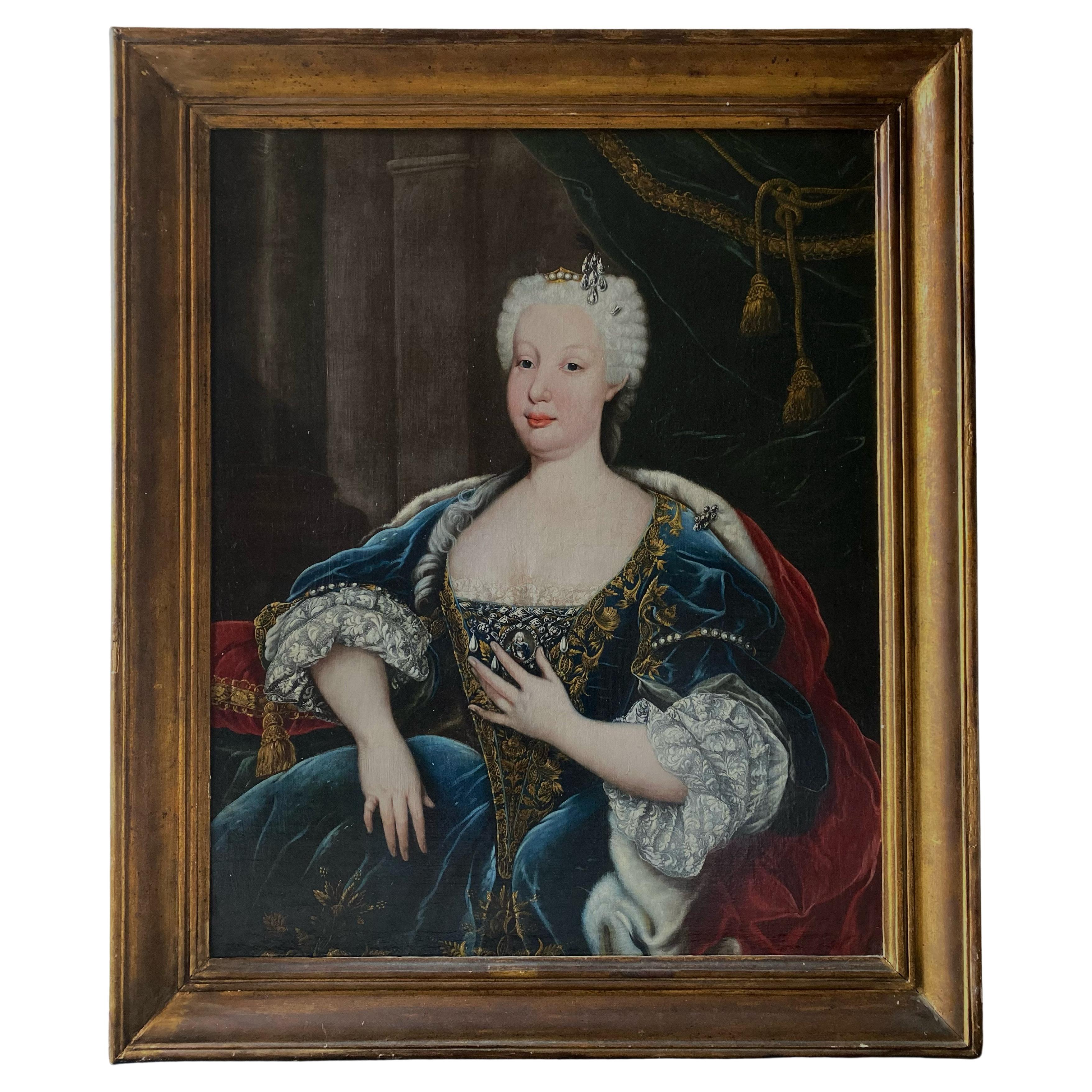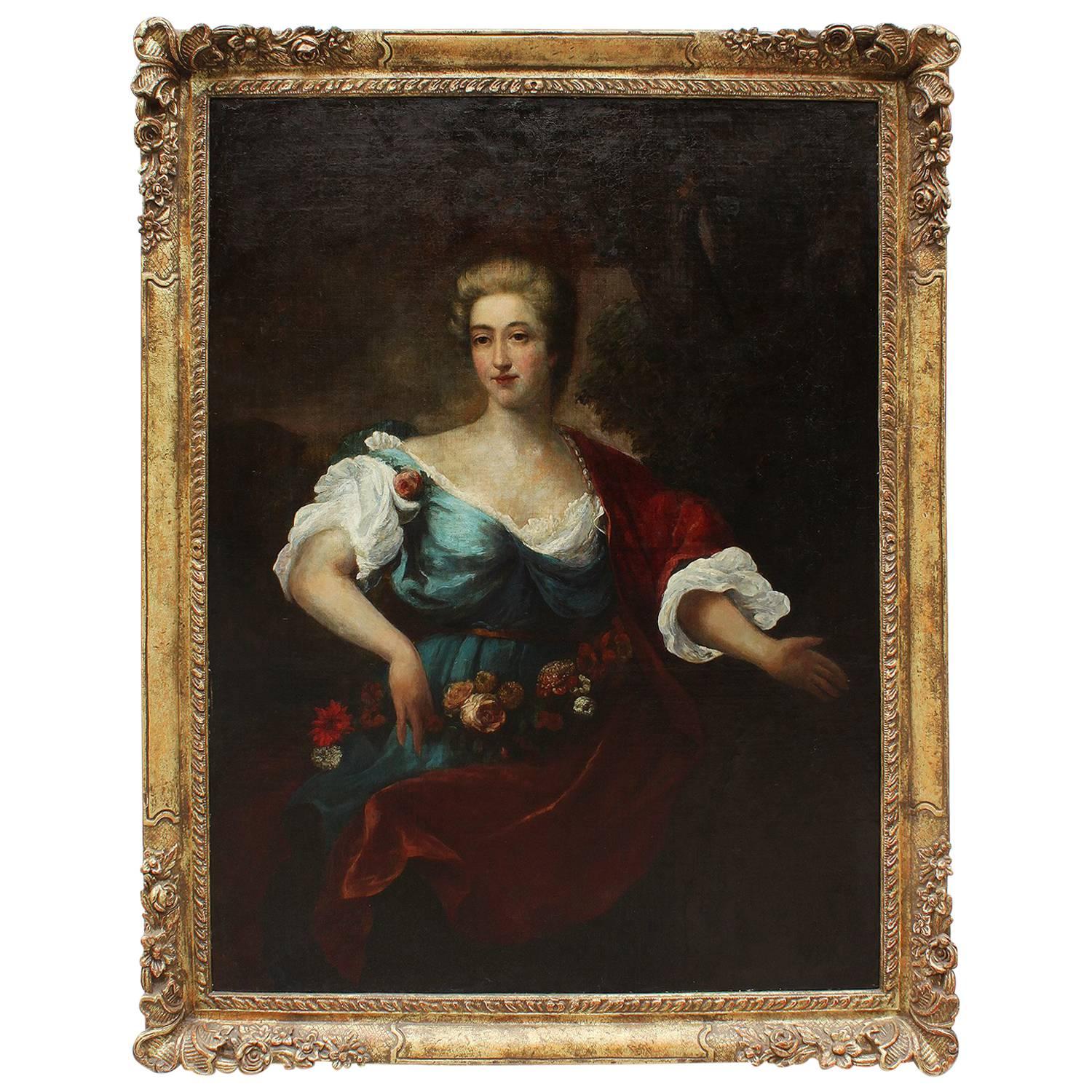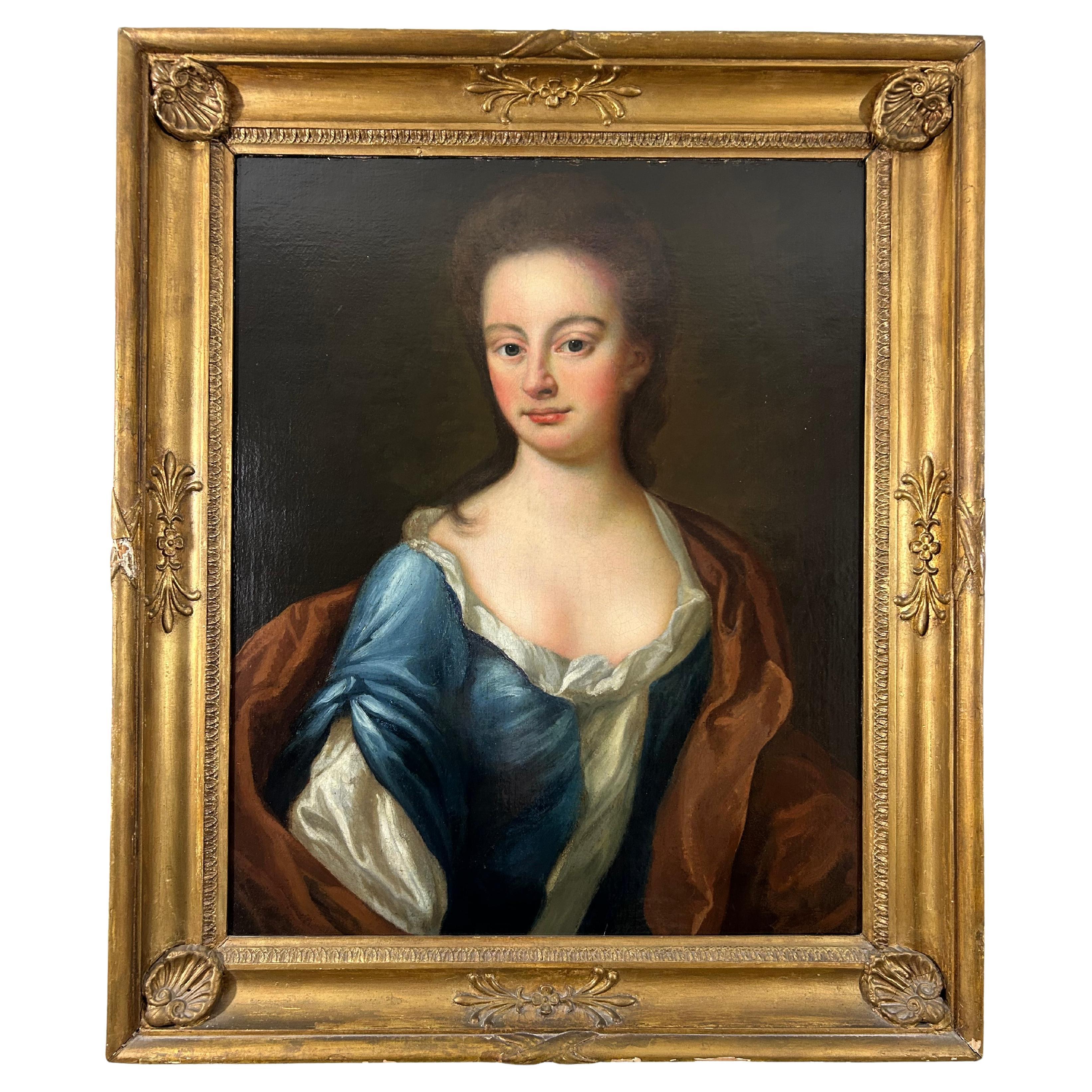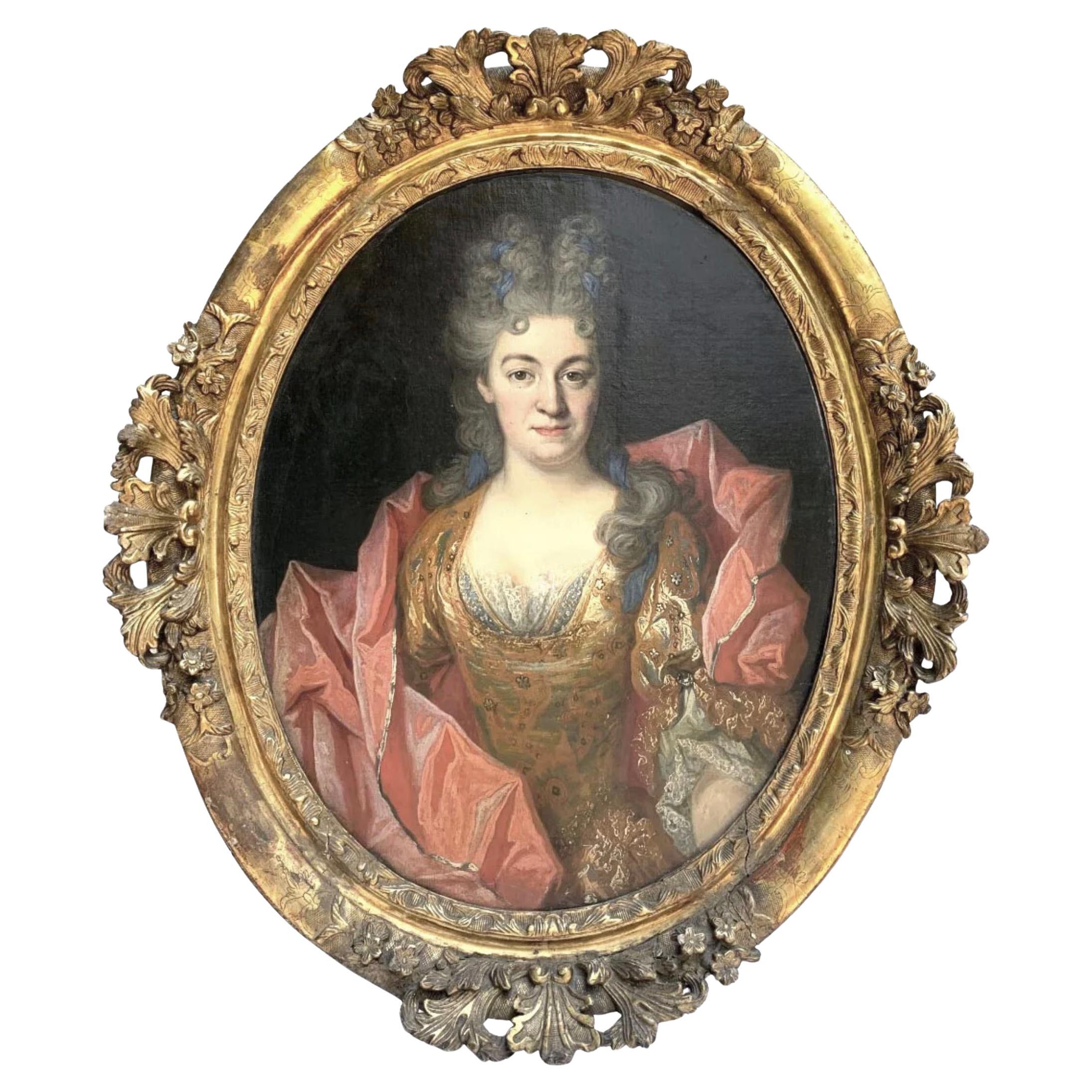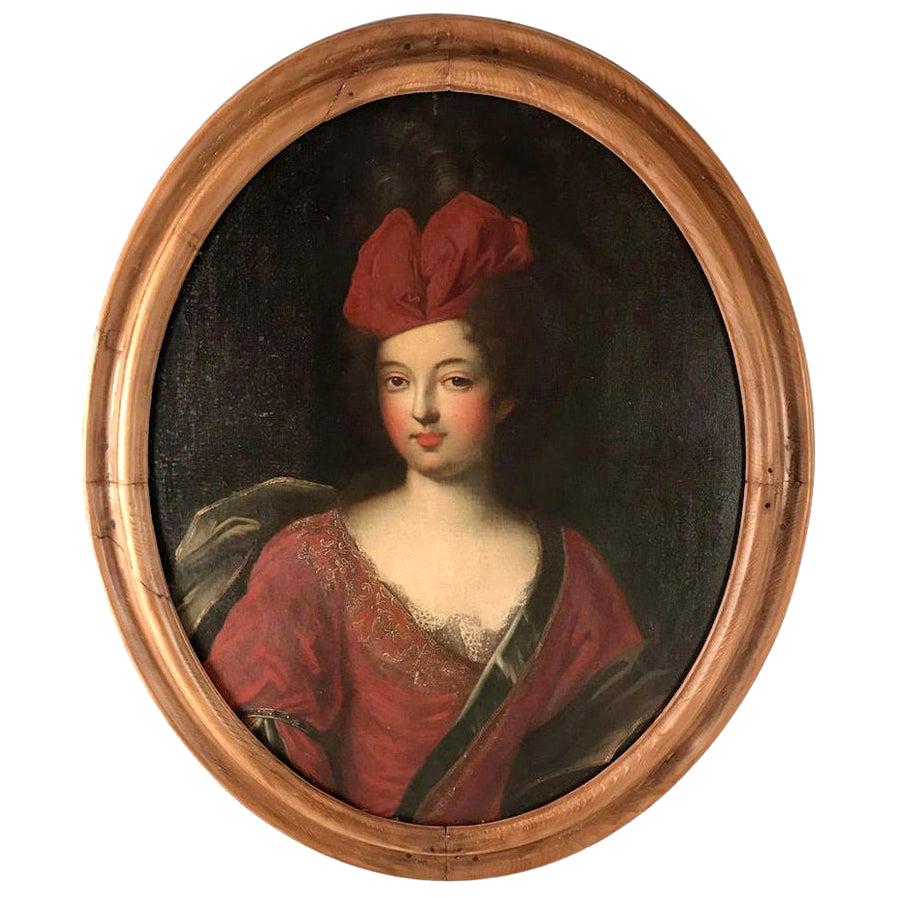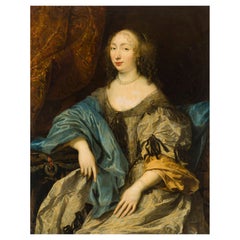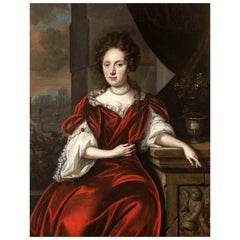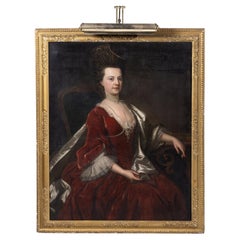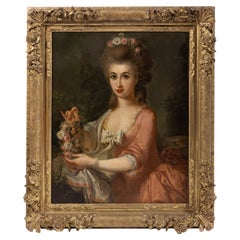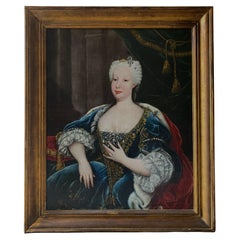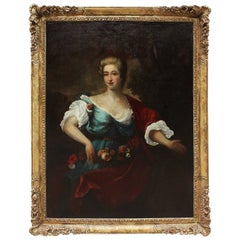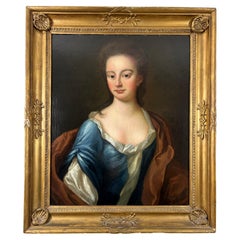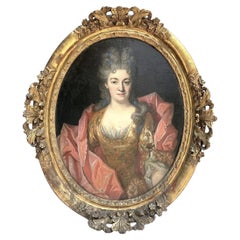Items Similar to Thomas VAN DER WILT (1659-1733) "Portrait of Noble Woman"
Want more images or videos?
Request additional images or videos from the seller
1 of 8
Thomas VAN DER WILT (1659-1733) "Portrait of Noble Woman"
$14,177.43
£10,626.86
€12,000
CA$19,477.38
A$21,744.66
CHF 11,393.88
MX$266,176.02
NOK 144,702.35
SEK 136,435.94
DKK 91,348.38
About the Item
Thomas VAN DER WILT (1659-1733) "Portrait of Noble Woman",
oil on canvas
55cm x 46cm without frame
65cm x 56cm with frame
very good conditions
Thomas van der Wilt (1659–1733) was an 18th-century painter from the Dutch Republic.
Biography
Van der Wilt was born in Piershil. Houbraken mentioned him as one of the pupils of Jan Verkolje. He became a master portrait painter in Delft, where he died.
According to the RKD he became the teacher of Jacob Campo Weyerman. He is known for portraits and historical allegories.
Thomas van der Wilt was born in Piershil (near Spijkenisse) as the son of the cloth merchant Willem van der Wilt and his wife Emmerentia van der Staf. He received his artistic training from Jan Verkolje (1650–1693), who took Thomas under his care upon the recommendation of the engraver Jan Goeree, who had discovered the youngster's talent. Van der Wilt settled in Delft, where he was the leading portrait painter in the first decades of the eighteenth century. Many prominent citizens sat for him, including Leiden burgomaster Adriaan van der Goes van Naters, as well as Haarlem burgomaster Cornelis Colterman, not to mention the well-known Amsterdam art collector Valerius Röver.
Van der Wilt was praised for his meticulous depiction of fine fabrics and carefully drawn hands, and his talent in these respects can be clearly seen in this work.
Van der Wilt also painted the portrait of the Delft writer and poet Hubert Kornelisz Poot.3 Upon Van der Wilt’s death in 1733, Poot wrote the following lines on the painter:
‘Hier sluimert VANDER WILT, 't thought ten roem geboren.
O gy, die kunst waerdeert, betreurt den schrandren man.
From schildermin, helaes! heeft meer aen hem verreren
Dan op den breedsten zerk de beitel schryven kan.’
- Creator:Europa (Artist)
- Dimensions:Height: 25.6 in (65 cm)Width: 22.05 in (56 cm)Depth: 2.37 in (6 cm)
- Style:Baroque (Of the Period)
- Materials and Techniques:Paint,Oiled
- Place of Origin:
- Period:
- Date of Manufacture:17th/18th Century
- Condition:Wear consistent with age and use. very good condition.
- Seller Location:Madrid, ES
- Reference Number:1stDibs: LU5779243648112
About the Seller
4.8
Platinum Seller
Premium sellers with a 4.7+ rating and 24-hour response times
Established in 2005
1stDibs seller since 2021
364 sales on 1stDibs
Typical response time: 1 hour
- ShippingRetrieving quote...Shipping from: Madrid, Spain
- Return Policy
Authenticity Guarantee
In the unlikely event there’s an issue with an item’s authenticity, contact us within 1 year for a full refund. DetailsMoney-Back Guarantee
If your item is not as described, is damaged in transit, or does not arrive, contact us within 7 days for a full refund. Details24-Hour Cancellation
You have a 24-hour grace period in which to reconsider your purchase, with no questions asked.Vetted Professional Sellers
Our world-class sellers must adhere to strict standards for service and quality, maintaining the integrity of our listings.Price-Match Guarantee
If you find that a seller listed the same item for a lower price elsewhere, we’ll match it.Trusted Global Delivery
Our best-in-class carrier network provides specialized shipping options worldwide, including custom delivery.More From This Seller
View All17th Century French School, Workshop of Jean Nocret "Portrait of a Woman"
By Europa
Located in Madrid, ES
17th-century French School, workshop of Jean Nocret
Portrait of a Woman with a Desk
Canvas (Antique Restorations)
107 x 84.5 cm
Good condition
A student of Jean Le Clerc, a Lorrain...
Category
Antique 17th Century French Baroque Paintings
Materials
Paint
Reinier de la Haye (1640-1695) - PORTRAIT OF A LADY IN FRONT OF A PARK LANDSCAPE
By Reinier De La Haye
Located in Madrid, ES
Reinier de la Haye (1640-1695) - PORTRAIT OF A LADY IN FRONT OF A PARK LANDSCAPE Signed R. de la Haye on the right on the architectural base. Seated figure of a noble lady, dressed i...
Category
Antique 17th Century Dutch Baroque Paintings
Materials
Paint
Important English School " LADY HAMILTON " 18th Century Sign
By Europa
Located in Madrid, ES
Important English School " LADY HAMILTON " 18th Century
Oil on canvas, 18th century English school.
Signed.
Small defects.
Dim.: 124 x 99 cm
good conditions
Category
Antique 18th Century English Baroque Paintings
Materials
Paint
FRENCH SCHOOL "Portrait of a Girl with Flowers". 18th Century
By Europa
Located in Madrid, ES
FRENCH SCHOOL
"Portrait of a Girl with Flowers".
Oil on canvas from the 18th century.
Relined.
Dimensions: 80 x 64 cm
Good condition
Category
Antique 18th Century French Baroque Paintings
Materials
Paint
French School 17th Century"Portrait with Coat of Arms Margueritte de Boutteville
Located in Madrid, ES
French School of 1659 17th century
"Portrait with Coat of arms of Margueritte Pierre de Boutteville"
around 1659
Oil on canvas with coat of arms and dated top right Provenance:
Bel...
Category
Antique 17th Century French Baroque Paintings
Materials
Paint
Circle of Alexis-Simon Belle (1674-1734) "Antique Portrait of a Young Girl"
By Europa
Located in Madrid, ES
Circle of Alexis-Simon Belle (1674-1734) "Antique Portrait of a Young Girl"
Oil on canvas.
Dimensions: H: 70 × W: 57 cm
Good condition
Alexis Simon Belle was born in Paris. He was t...
Category
Antique 17th Century French Baroque Paintings
Materials
Paint
You May Also Like
Portrait of D. Maria Bárbara De Bragança, Circle of Louis-Michel Van Loo
By H. van Loon
Located in Lisboa, PT
PORTRAIT OF D. MARIA BÁRBARA DE BRAGANÇA (1711-1758), QUEEN OF SPAIN
Circle of Louis-Michel van Loo (1707-1771)
Oil on canvas
Her Royal Highness, the Infanta Maria Barbara of Braganza (1711-1758) was the first-born child of King John V of Portugal (1689-1750) and his queen consort Maria Anna of Austria (1683-1754). Born in December 1711, she had the Convent Palace of Mafra built in her honour following a vow made by her royal father. Her status as Princess of Brazil, inherent to 18th century Portuguese presumptive heirs, would however be superseded once the queen gave birth to two male princes, D. Pedro (1712-1714) and D. José (1714-1777), preventing her from ascending to the throne.
Daughter of one of the most illustrious monarchs of his time, Maria Barbara was carefully educated to become a fond admirer of the arts, and of music in particular, having had the Italian composer Domenico Scarlatti (1685-1757) as her music teacher.
On the 10th January 1723 the young princess was betrothed to the Infante Ferdinand of Spain (1713-1759), eldest son of King Philip V (1683-1746). Six years later, on the 19th January, she entered her new country in a carefully choreographed ceremony that became known to history as the “Exchange of the Princesses”. This unique event took place on a specially built Bridge-Palace, a wooden, luxuriously decorated structure that included various modules and rooms, on both banks of the river Caia, the natural border between the town of Elvas in Portugal and of Badajoz in Spain. Simultaneously, on the same day that the Portuguese Infanta crossed the border to marry the Spanish Crown Prince, her new sister in law, the Infanta Mariana Victoria of Bourbon (1718-1781), her husband’s sister, crossed the same bridge in the opposite direction to marry Prince D. José, the Portuguese heir to the throne.
Once married, Maria Barbara would spend 17 years as Princess of Asturias, only becoming Queen of Spain at her husband’s accession following the death of Philip V in 1746. She is portrayed in the 1743 painting by Louis-Michel van Loo (1707-1771) now in the Prado Museum, in which Philip V had himself represented with all his close family.
The new Queen would take an important role at court eventually becoming the liaison between her husband and the King of Portugal, particularly throughout the negotiations for the Treaty of Madrid (1746-1750). Maintaining her interest in music, she patronized the Italian castrato singer Farinelli (1705-1782) while remaining close to her old master Scarlatti, having herself composed some sonatas for a large orchestra. She would also commission and fund the building of the Royal Salesians Monastery complex in central Madrid, where both her and Ferdinand VI are buried.
The portrait we are presenting for sale shows the Queen in half-length, turning left at three quarters. She is wearing a blue low-cut dress embroidered with flowers and foliage, over a lace cuffed white blouse, and an ermine cloak pined on the left-hand side by a diamond broach. The powdered hair style is held sideways by a seven diamond and black plume headdress and topped by a small gold and pearl crown. The right arm rests on a cushion while the left hand, at chest height, holds a miniature male portrait.
The Infanta’s features are analogous to the 1725 portrait by the painter Domenico Duprà (1689-1770), also in the Prado Museum collection. Further similarities can be found in another portrait by Louis-Michel van Loo, in which a seven diamond and black plume headdress is also present. In this work, the cushion supporting Maria Barbara’s right arm has also some obvious similarities to our painting. The same diamond headdress reappears in Van Loo’s above-mentioned portrait of Philip V’s family dated from 1743.
It is nevertheless in Lisbon’s Ajuda National Palace that it is possible to find an almost identical depiction of the Infanta holding a miniature portrait of her husband. In it, the future Ferdinand VI is portrayed facing right at three quarters and wearing a curly wig, suit of armour, the golden fleece insignia and a blue band, in a composition that closely resembles an 18th century Spanish school painting that appeared in the art market in January 2016.
Another detail common to various portraits of the Portuguese Infanta and Queen of Spain is the small gold and pearl crown on her head. In another Van Loo painting, also from the Prado Museum, in which Maria Barbara is portrayed as Queen, this crown is represented together with a headdress similar to the one previously described. Another two paintings by the same artist, at the Royal Academy of Saint Ferdinand, include the same ornament.
We must also refer the paintings by the artist Jean Ranc (1674-1735). In one, dating from 1729 (Prado Museum), the Infanta is depicted outdoors holding a flower bouquet and wearing a yellow silk dress with red cloak, and a set of diamond and ruby jewellery that includes a headdress similar to the one present in our portrait. Another work by the same artist, belonging to the Complutence University of Madrid, depicts the Infanta sumptuously dressed in identical colours to our painting and wearing an elaborate headdress and diadem.
These portraits, beyond their iconographical importance as contemporary records of the Infanta and Queen Maria Barbara, are also illustrative of 18th century fashion for jewelled head dressing. Often, flowers were combined with joyful adornments, composing almost theatrical displays that would reinforce the ostentatious nature of the image. The ornamental flowers and the chromatic character of the jewels would complement the luxury of the colourful dresses in blue, crimson, green or other silk shades, in compositions whose sole purpose was to highlight a royal sitter’s wealth and power, becoming an essential statement accessory within the strict court protocols and codes of conduct.
Circle of Louis-Michel van Loo (1707-1771)
Slowly but steadily, the resolute, tranquil and dignified attitude of Renaissance and Baroque portraiture becomes artificial and presumptuous. Mid 18th century society favours elusive expression and psychological deepness, albeit limited to the face, that, with emphasis on detail, on the rich colour palette and on changing costumes and landscapes, associated to the courtliness of gestures, creates a strongly artificial environment while maintaining a highly poetic intrinsic character.
Louis-Michel van Loo followed a dynasty of famous Dutch origin artists that had settled in France. Initially taught by his father, Jean-Baptiste von Loo (1684-1745), the younger van Loo studied in Turin and Rome and frequented the Paris Academy. In Rome he worked with his uncle Charles-André van Loo (1705-1765) and become a painter for the Turin Court. In 1737 he arrived in Spain being summoned by Philip V to succeed Jean Ranc as painter of the king’s chamber.
In Madrid, his work covers the numerous Court commissions and the Royal Saint Ferdinand Fine Arts Academy, of which he was a founding member and director for the Painting department in 1752. Is production at court consisted essentially of numerous portrait paintings, often Royal gifts...
Category
Antique 18th Century Spanish Baroque Paintings
Materials
Canvas
French 18th-19th Century Oil on Canvas Portrait of Lady, after Jean-Marc Nattier
By Jean-Marc Nattier
Located in Los Angeles, CA
A very fine French 18th-19th century oil on canvas portrait of a posing lady with flowers, after Jean-Marc Nattier (1685-1766) within an ornate gilt wood carved frame, circa 1800.
...
Category
Antique Early 19th Century French Louis XV Paintings
Materials
Canvas, Giltwood
$11,960 Sale Price
20% Off
Early Nineteenth Century Portrait of a Lady
Located in Toronto, CA
A stunning oil portrait in the manner of Allan Ramsay, a Scottish painter who was renowned for his portraits in the 18th century. (1813-1784) This is a beautifully executed painting...
Category
Antique Early 19th Century British Baroque Paintings
Materials
Canvas, Wood
Circle of Nicolas de Largillière 1656 -1746 Portrait of a Noble Lady
By (circle of) Nicolas de Largillierre
Located in Rio De Janeiro, BR
This striking oval portrait, attributed to the circle of Nicolas de Largillière, exemplifies the refined elegance and artistic sophistication of late 17th to early 18th-century Frenc...
Category
Antique Late 17th Century French Baroque Paintings
Materials
Canvas
Late 17th Century Oil Portrait of a Lady
Located in Lymington, GB
An oil on canvas portrait of a young French courtier, circa 1690.
This evocative antique French-school picture has been attributed to the portrait painter Jean-François de Troy (1679-1752).
De Troy was famous as a portrait painter of fashionable society women.
This is a very attractive late-17th century painting surviving in its original frame and stretcher. The canvas appears to be untouched.
References:
'Jean François de Troy, The Alarm, or the Gouvernante Fidèle', at the Victoria and Albert Museum, London.
'Jean François de Troy, Paris 1679 - Rome 1752', at the Thyssen-Bornemisza Museum.
Laurie G. Winters, Troy, de, Grove Art Online, Oxford Art Online, Oxford University Press, 6 May 2016.
Everett Fahy & Jayne Wrightsman...
Category
Antique 17th Century French Paintings
Materials
Canvas
A Portrait Of A Lady Of Quality, Oil On Canvas, 18th Century
Located in Honnelles, WHT
A Portrait Of A Lady Of Quality, Oil On Canvas, 18th Century
Category
Antique Late 18th Century French Modern Drawings
Materials
Canvas
More Ways To Browse
Yuan Porcelain
17th Century China Cabinet
1970s Double Bed
20 Francs
3 Drawer Chest Lacquered
A H Davenport
Antique 18 Wheelers
Antique Bed Frames Mahogany
Antique Birch Desk
Antique Butler Cabinet
Antique Capo
Antique Chinese Red Lacquer Cabinet
Antique Clock And Candlesticks
Antique Dome Top Chest
Antique Folding Fans
Antique French Oven
Antique Furniture Brunswick
Antique Furniture Kits
